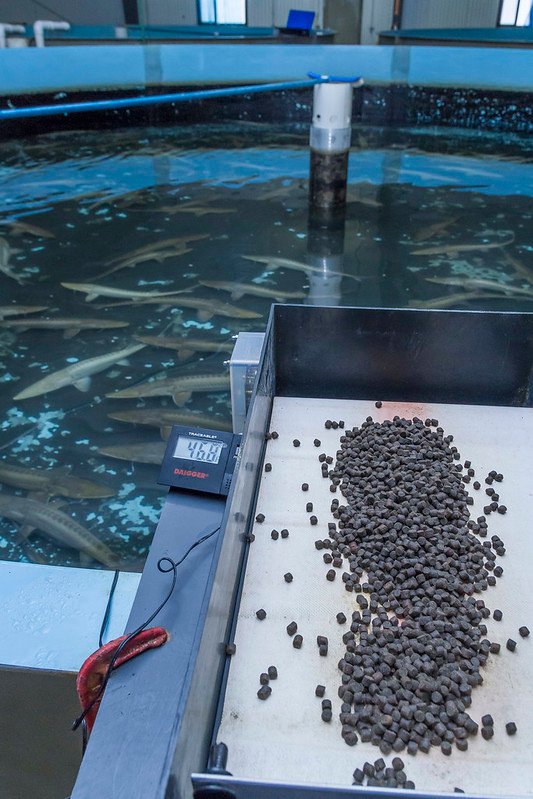
One of the objectives of the iFishIENCi project is to bring to market the iFishIENCi Biology Online Steering System (iBOSS), which significantly improves control and management of production for all fish farming systems.
In iBOSS, intelligent functions can be implemented to take advantage of data from multiple sources to facilitate decision-making by fish farmers, optimize production, improve production planning, etc.
The final report on intelligent feeding AI aims to implement one of the intelligent functions: iBOSS Smart Feeding (intelligent feeding).
Using an Artificial Intelligence approach, appropriate correlations are expected to be found between fish behavior, feeding regime, and water quality in order to control feed and achieve optimal feeding operations.
According to the report, there is a lot of data available; however, it has not yet been explored how to concatenate this into a model to optimize feeding efficiency.
In this sense, the document proposes an approach to integrate multiple sources of quantification of feeding efficiency into one.
The study describes data collection, implementation of new sensors, and observations of fish behavior, which contribute to the development of Artificial Intelligence (AI) algorithms to optimize the use of feed.
Additionally, the document describes the testing and validation of Artificial Intelligence algorithms.
Stay Always Informed
Join our communities to instantly receive the most important news, reports, and analysis from the aquaculture industry.
What is intelligent feeding?
To understand the described approaches, a clear definition of Smart Feeding is required.
iBOSS Smart Feeding aims to maximize the utilization of feed while minimizing environmental impacts by optimizing the efficiency of exposing fish to feed in relation to the state of the fish (e.g. satiety, stress), behavior, environmental conditions, and specific species characteristics, in order to maximize growth and reduce feed loss.
Researchers developed multiple Artificial Intelligence models and present their interpretation of feeding efficiency.
All interpretations are integrated into an Automatic Decision Making System (ADMS) to provide the feeder with a signal to increase or decrease feeding.
ADMS changes can be reflected in quantity, frequency, or both.
Field experiments
Experiments and data collection were conducted at two pilot sites (ABT-Malta and HCMR-Crete), which were used to develop the Artificial Intelligence algorithm.
The ABT site in Malta is a recirculation system for aquaculture (RAS), while the HCMR site has cages and a RAS system.
Both sites were chosen to implement standard water quality sensors that were connected to the cloud, as well as installing a camera system for each site.
Detection
Fish detection was achieved using a deep object detection model implemented in Python, YOLOv5. For calibration, researchers used a pre-trained light model, and re-trained it with 148 images from ABT tank videos, manually labeled in BiOceanOr software.
The model has an accuracy of 82%.
Feeding monitoring and abnormal behaviors
“The system is capable of distinguishing between three different models of feeding-related movements: polarized movement before feeding occurs, movement that resembles feeding behavior but lasts for a limited period of time, and the feeding event where fish gather by swirling around the feed,” the report describes.
Additionally, based on changes in fish group density during feeding, the system is able to monitor feeding evolution and detect when fish group density is decreasing.
Perspectives
The report presents the current state of development of iBOSS Smart Feeding AI, and includes descriptions of several approaches to extract information from the fish status that will make it possible for iBOSS to make decisions about the feeding intensity.
iBOSS will be a useful tool for fish farmers to optimize the use of feed while improving feed conversion ratio.
The iBOSS Smart Feeding AI will become self-evolving in the sense that when the AI model is updated with new data, such as feeding intensity, water quality, fish behavior, growth, etc., the AI will evolve and optimize its models continuously.
Once the project is complete, fish farmers will be able to obtain a valuable tool to reduce feeding costs and predict when the fish are ready for harvesting.
Reference (open access)
Jensen, Christian, Le Gall, Franck, Trotignon, Dimitri, Abid, Ahmed, De Prisco , Joseph, & Budaev, Sergei. (2022). iFishIENCi Report on final Smart feeding AI (Version 2). Zenodo. https://doi.org/10.5281/zenodo.7889609
Editor at the digital magazine AquaHoy. He holds a degree in Aquaculture Biology from the National University of Santa (UNS) and a Master’s degree in Science and Innovation Management from the Polytechnic University of Valencia, with postgraduate diplomas in Business Innovation and Innovation Management. He possesses extensive experience in the aquaculture and fisheries sector, having led the Fisheries Innovation Unit of the National Program for Innovation in Fisheries and Aquaculture (PNIPA). He has served as a senior consultant in technology watch, an innovation project formulator and advisor, and a lecturer at UNS. He is a member of the Peruvian College of Biologists and was recognized by the World Aquaculture Society (WAS) in 2016 for his contribution to aquaculture.




